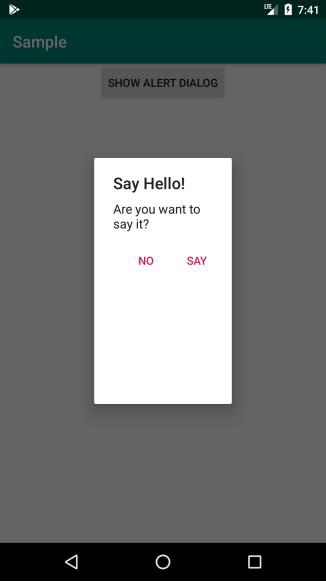
 Data Structure
Data Structure Networking
Networking RDBMS
RDBMS Operating System
Operating System Java
Java MS Excel
MS Excel iOS
iOS HTML
HTML CSS
CSS Android
Android Python
Python C Programming
C Programming C++
C++ C#
C# MongoDB
MongoDB MySQL
MySQL Javascript
Javascript PHP
PHP
- Selected Reading
- UPSC IAS Exams Notes
- Developer's Best Practices
- Questions and Answers
- Effective Resume Writing
- HR Interview Questions
- Computer Glossary
- Who is Who
How to make an alert dialog fill 50% of screen size on Android device?
This example demonstrates how to make an alert dialog to fill 50% of screen size on an Android device.
Step 1 − Create a new project in Android Studio, go to File ⇒ New Project and fill all required details to create a new project.
Step 2 − Add the following code to res/layout/activity_main.xml.
<?xml version="1.0" encoding="utf-8"?> <androidx.coordinatorlayout.widget.CoordinatorLayout xmlns:android="http://schemas.android.com/apk/res/android" xmlns:app="http://schemas.android.com/apk/res-auto" xmlns:tools="http://schemas.android.com/tools" android:layout_width="match_parent" android:layout_height="match_parent" android:fitsSystemWindows="true" android:id="@+id/coordinator_layout" tools:context=".MainActivity"> <Button android:id="@+id/btnAlert" android:layout_width="wrap_content" android:layout_height="wrap_content" android:text="Show Alert Dialog" android:layout_gravity="top|center_horizontal" tools:ignore="MissingConstraints" /&glt; </androidx.coordinatorlayout.widget.CoordinatorLayout>
Step 3 − Add the following code to src/MainActivity.java
package com.app.sample;
import androidx.appcompat.app.AppCompatActivity;
import androidx.coordinatorlayout.widget.CoordinatorLayout;
import android.app.AlertDialog;
import android.os.Bundle;
import android.app.Activity;
import android.content.Context;
import android.util.DisplayMetrics;
import android.view.View;
import android.view.WindowManager;
import android.widget.Button;
public class MainActivity extends AppCompatActivity {
private Context mContext;
private Activity mActivity;
private CoordinatorLayout mCLayout;
private Button mButton;
@Override
protected void onCreate(Bundle savedInstanceState) {
super.onCreate(savedInstanceState);
setContentView(R.layout.activity_main);
mContext = getApplicationContext();
mActivity = MainActivity.this;
mCLayout = (CoordinatorLayout) findViewById(R.id.coordinator_layout);
mButton = (Button) findViewById(R.id.btn_alert);
mButton.setOnClickListener(new View.OnClickListener() {
@Override
public void onClick(View view) {
AlertDialog.Builder builder = new AlertDialog.Builder(mActivity);
builder.setTitle("Say Hello!");
builder.setMessage("Are you want to say it?");
builder.setPositiveButton("Say",null);
builder.setNegativeButton("No",null);
AlertDialog dialog = builder.create();
dialog.show();
DisplayMetrics displayMetrics = new DisplayMetrics();
getWindowManager().getDefaultDisplay().getMetrics(displayMetrics);
int displayWidth = displayMetrics.widthPixels;
int displayHeight = displayMetrics.heightPixels;
WindowManager.LayoutParams layoutParams = new WindowManager.LayoutParams();
layoutParams.copyFrom(dialog.getWindow().getAttributes());
int dialogWindowWidth = (int) (displayWidth * 0.5f);
int dialogWindowHeight = (int) (displayHeight * 0.5f);
layoutParams.width = dialogWindowWidth;
layoutParams.height = dialogWindowHeight;
dialog.getWindow().setAttributes(layoutParams);
}
});
}
}
Step 4 − Add the following code to Manifests/AndroidManifest.xml
<?xml version="1.0" encoding="utf-8"?> <manifest xmlns:android="http://schemas.android.com/apk/res/android" package="com.app.sample"> <application android:allowBackup="true" android:icon="@mipmap/ic_launcher" android:label="@string/app_name" android:roundIcon="@mipmap/ic_launcher_round" android:supportsRtl="true" android:theme="@style/AppTheme"> <activity android:name=".MainActivity"> <intent-filter> <action android:name="android.intent.action.MAIN" /> <category android:name="android.intent.category.LAUNCHER" /> </intent-filter> </activity> </application> </manifest>
Let's try to run your application. I assume you have connected your actual Android Mobile device with your computer. To run the app from the android studio, open one of your project's activity files and click Run ![]() icon from the toolbar. Select your mobile device as an option and then check your mobile device which will display your default screen −
icon from the toolbar. Select your mobile device as an option and then check your mobile device which will display your default screen −

Click here to download the project code.

